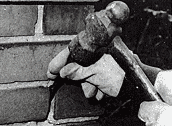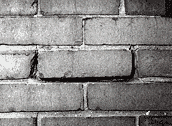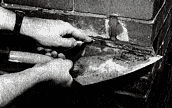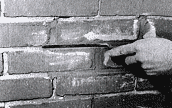Mixing the PRO FINISH QUIKRETEŽ Blended Mortar Mix
While PRO FINISH QUIKRETEŽ Blended Mortar Mix is the product of choice for most applications, especially larger jobs, other QUIKRETEŽ products also give excellent repointing results. If you plan to make a number of concrete repairs such as filling cracks, repairing chipped edges, resurfacing scaled areas, as well as doing some repointing, QUIKRETEŽ Vinyl Concrete Patcher can handle all these jobs. And if you plan to patch leaks in block or brick walls with QUIKRETEŽ Hydraulic Water-Stop Cement, repoint the surrounding joints as well. Always follow the directions listed on the individual product package.
When using PRO FINISH QUIKRETEŽ Blended Mortar Mix for repointing, it is recommended that you prehydrate the mortar prior to tuck-pointing joints. This step will greatly reduce the shrinkage of any of the joints away from the edge of the bricks and cut down on the number of hairline cracks that occur when the mortar begins to dry against the old bricks.
To prehydrate the mortar, mix the required amount of PRO FINISH QUIKRETEŽ Blended Mortar Mix with just enough water to form a damp unworkable mix that retains its form when pressed into a ball in the hand. Let the mortar set for about 30 to 45 minutes, and then add enough water to make the mortar workable. The end result will be a mix slightly drier than that normally used to lay new brick. Never make large batches of mortar for repointing; mix an amount you can use in about 45 minutes.
Preparing the Joints
1. Cut out the mortar joints to an approximate depth of ¾" to 1". Use of the special plugging or joint chisel will help prevent binding in the joint and chipping of the brick edges.
2. A clean surface is needed for good bonding. Use the jointer tool to rake out excess mortar or grit, and brush out the joints to remove loose mortar or sand.

3. Flush out any remaining particles with a garden hose equipped with a spray attachment.

Replacing Bad Bricks
Any bricks in the wall that are badly broken or deteriorated should be cut out and replaced prior to repointing. Select new bricks that match the old bricks as closely as possible.
1. Cut the old brick completely out of the wall.
2. Clean out the recess carefully.
3. Wet the cavity and the replacement unit with a brush or fine spray of water. When the cavity is damp, but not wet, apply a thick layer of PRO FINISH QUIKRETEŽ Blended Mortar Mix to the bottom and sides of the cavity.
4. Butter the top of the replacement brick and slide it into the cavity. Mortar should squeeze out from the joints. If it does not, rebutter the joint, adding more mortar.
Repointing
1. Dampen the cleaned joints with a brush and water.
2. Load the trowel with mortar. Pick up the mortar from the trowel with the jointer tools and press it into the joints. Pack the mortar firmly into the joints. Repoint the head joints first and the bed joints second. This sequence allow you to make unbroken horizontal strokes with the jointer to form straight, even bed joints.

3. In most cases, joints are filled flush to the wall face, then slightly depressed with the jointer and brushed clean. If concave or V joints were used in the original work, strike with the proper tool for these finishes after the repointing is done and before the mortar gets too hard to work.

4. To decrease the possibility of cracking or sagging in extremely deep joints, fill in about half of the joint depth, wait until the mortar is thumbprint hard, and then repoint the remainder of the joint.
5. In hot or windy conditions, dampen the repointed joints to prevent the mortar from drying too fast. Spray the finished job with a fine water mist to aid in the curing process.
6. Repointing of stonework and block is essentially the same as brickwork. Tool the joints to match those in the sound sections of the wall.
|
